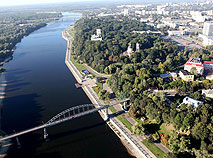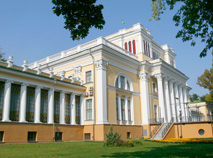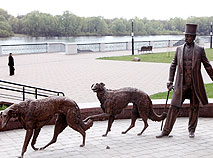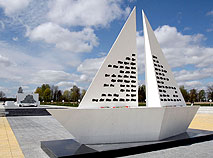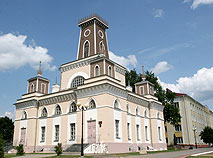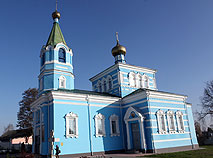Gomel Oblast Landmarks

A picturesque valley of the Pripyat River, centennial oak woods and bogs called Europe’s lungs – this is Belarusian Polesie. The region is surrounded by numerous legends and associated with important historical events. Famous ancient settlements Yurovichi and Berdyzh were unearthed in present-day Gomel Oblast. Here one can find Eastern Europe’s biggest burial mounds dating back to the Kievan Rus period (about 600 mounds) and beautiful architectural monuments. Wooden churches, a special pride of the region, were nominated for inscription on the UNESCO World Heritage List.
Gomel

The magnificent Rumyantsev-Paskevich Palace has been the hallmark of the city for more than two centuries. It is one of Belarus’ most popular sites. Besides the palace, the architectural compound features Sts Peter and Paul Cathedral, a chapel and a family vault of the Paskevich family, and a monument to Nikolai Rumyantsev-Zadunaisky. The legendary Hunter House became home to the Gomel History Museum. The residence is surrounded by an ancient park with exotic trees, flower gardens, grottos, fountains and summerhouses. In its heyday it was one of Europe’s best parks. Sovetskaya Street connects the park with the city center and the Gomel Circus. The street is famous for its original, “gingerbread”, Modern-style houses.
![]() A monument to the first resident of Gomel was mounted on the Kievan Slope on the bank of the Sozh River. The city’s first resident is depicted with a quiver of arrows on his back and a lynx – the symbol of Gomel – by his side.
A monument to the first resident of Gomel was mounted on the Kievan Slope on the bank of the Sozh River. The city’s first resident is depicted with a quiver of arrows on his back and a lynx – the symbol of Gomel – by his side.
![]() 300km far from Minsk
300km far from Minsk
Palace of the Rumyantsevs and the Paskeviches

The Gomel Palace proudly overlooks the banks of the Sozh River. It once belonged to one of the favorites of Catherine II, Count Pyotr Rumyantsev-Zadunaisky. In the 19th century it was purchased by the famous Field Marshal Ivan Paskevich. He put together an extensive collection of works of art and antiques. The last owner of the palace was Irina Paskevich. She was the first to translate Leo Tolstoy’s novel War and Peace into French. Today the holdings of the museum feature over 150,000 original exhibits. Among them is the Eleusa Icon from the family vault of the Paskevich family. The icon was made by the famous Faberge company and the Vladimir Frolov workshop in 1887-1910.
![]() 4 Lenina Street, Gomel
4 Lenina Street, Gomel ![]() Open from 11.00 to 19.00; off on Monday
Open from 11.00 to 19.00; off on Monday
Vashchenko Art Gallery

The exposition of the gallery tells a story of life and work of one of Belarus’ most famous artists Gavriil Vashchenko. In 1992 and 1994 the People’s Artist of Belarus was named Person of the Year by the International Biographical Center of Cambridge. His works are displayed by some 30 biggest museums of the world, including the Tretyakov Gallery (12 paintings). However, the biggest collection of his works, including watercolors and sketches, can be found in Gomel. It took more than 50 years to put together such an extensive collection. Most of the works of the artist depict his native land of Polesye.
![]() 4 Karpovicha Street, Gomel
4 Karpovicha Street, Gomel ![]() Open from 10.00 to 19.00
Open from 10.00 to 19.00
Gomel Regional Military History Museum

The military history museum was opened in Gomel in 2005, the year when Belarus celebrated 60 years since its liberation from the Nazi invaders. The exposition covers Belarus’ history from ancient times to the present. It features weapons, ammunition, gear and uniforms, movies, documents, manuscripts and photos. The pride of the museum is the Partisans’ Town located in the open air, as well as the exposition of the 20th century weaponry. Among the exhibits are ZSU-23-4 “Shilka” (a lightly armored, self-propelled, radar guided, anti-aircraft weapon system) and the BMD-1 (an airborne amphibious tracked infantry fighting vehicle).
![]() 5 Pushkina Street, Gomel
5 Pushkina Street, Gomel ![]() Open from 11.00 to 19.00 (May-September); from 10.00 to 18.00 (October-April).
Open from 11.00 to 19.00 (May-September); from 10.00 to 18.00 (October-April).
![]() A separate building houses the Crime Museum where one can see weapons, ammunition and gear of the law enforcement, visit a forensic laboratory of the late 20th century, study fake documents and notes used by criminals and take part in a forensic examination.
A separate building houses the Crime Museum where one can see weapons, ammunition and gear of the law enforcement, visit a forensic laboratory of the late 20th century, study fake documents and notes used by criminals and take part in a forensic examination.
![]() 1 Pushkina Street, Gomel
1 Pushkina Street, Gomel ![]() Open from 11.00 to 19.00 (May-September); from 10.00 to 18.00 (October-April); off on Monday, Tuesday.
Open from 11.00 to 19.00 (May-September); from 10.00 to 18.00 (October-April); off on Monday, Tuesday.
National Park Pripyatsky

A unique nature reserve between the rivers Pripyat, Stviga and Ubort is the only place in the world with intact ancient inundated oak woods. It is also Europe's largest area of transitional and high swamps. In addition, the National Park Pripyatsky has the status of the key ornithological territory. The bottomland of the Pripyat River is Europe’s largest migration streambed of migratory birds. It is also home to over 250 species of birds (79% of all the birds in Belarus), among which are the rare grey crane, black stork, short-eared owl, white-tailed eagle... For tourists the park offers photo safaris (trips to watch animals in the wild); sightseeing tours along ecological paths; motor ship and boat tours; fishing and hunting.
![]() Once in two years the National Park Pripyatsky organizes the international festival of ethnocultural traditions Polesie’s Call.
Once in two years the National Park Pripyatsky organizes the international festival of ethnocultural traditions Polesie’s Call.
![]() Lyaskovichi agro-town, Petrikov District, 260km far from Minsk, 270km far from Gomel.
Lyaskovichi agro-town, Petrikov District, 260km far from Minsk, 270km far from Gomel.
Turov

Along with Polotsk, the ancient Turov is a big religious and spiritual center of Belarus. It was first mentioned in chronicles in 980. Turov’s cathedral was the second largest church in Belarus after St. Sophia’s in Polotsk, (unfortunately it has not survived because of the marshy soils). The Turov Gospel, one of the first masterpieces of the East Slavic written language, was created here in 1056-1057. The town was home to the famous "Belarusian Chrysostom” - preacher and theologian Kirill of Turov. Turov is proud of the surviving settlement dating back to the 10th-13th centuries with the remains of a temple and dwellings, the Church of All Saints, an outstanding specimen of wooden architecture, and the unique stone crosses...
![]() A legend says that the stone crosses came upstream the Dnieper and Pripyat rivers from Kiev where Prince Vladimir baptized Rus. Two of them ("the father" and "the mother") are held in the Church of All Saints, and the third one inside of the monument to Kirill of Turov on the Castle Hill.
A legend says that the stone crosses came upstream the Dnieper and Pripyat rivers from Kiev where Prince Vladimir baptized Rus. Two of them ("the father" and "the mother") are held in the Church of All Saints, and the third one inside of the monument to Kirill of Turov on the Castle Hill.
![]() Zhitkovichi District
Zhitkovichi District
Mozyr

Mozyr is one of the oldest towns in Belarus: the remains of five ancient settlements with the oldest being four thousand years old were found on the territory of the town. In the 15th century in the center of Mozyr there was a castle that was repeatedly ravaged by the Tatars, and in 1649 was captured and burned down by Prince Janusz Radziwill. In 2005 by the 850th anniversary of the town, the wooden Mozyr Castle was restored on its historic site. Since then it has become a popular tourist attraction. The most iconic sites in the town are the Roman-Catholic Church of St. Michael the Archangel and the Bernardine monastery of the 17th century, St. Michael's Cathedral, a brewery founded in 1885, the building of the male gymnasium of the 19th century and St. Nicholas Church in the Constructivism style.
![]() 126km far from Gomel, 281km far from Minsk
126km far from Gomel, 281km far from Minsk
![]() Mozyr Castle open-air exposition open from 10.00 till 18.000, off on Monday.
Mozyr Castle open-air exposition open from 10.00 till 18.000, off on Monday.
Yurovichi

The settlement of primeval people in the village of Yurovichi is about 25 thousand years old. Back in 1929, Belarusian archeologists found a settlement and during the subsequent expeditions unearthed the remains of 20 mammoths, a prehistoric bull, and a wild horse. Near the ancient dwelling of rounded shape built of bones, skins and impressive stones at the base, the archeologists found segmented blades, scrapers, and a silicon dagger. In the 1970s, archaeologists discovered five more settlements, including three Neolithic settlements, a settlement of the Bantserov culture and, most importantly, the remains of a medieval town of the 9th-10th centuries. It was as big as Polotsk but disappeared for unknown reasons and was not mentioned in historical chronicles.
![]() Village of Yurovichi, Kalinkovichi District
Village of Yurovichi, Kalinkovichi District
Yurovichi Monastery

Yurovichi Monastery of the Nativity of Theotokos is the only specimen of the Vilnius Baroque in Gomel Oblast. It was founded by the Jesuits in the early 18th century to preserve the relic worshipped by both the Orthodox and Catholic believers - the wonderworking icon of the Merciful Mother of God of Yurovichi. In 1855 the relic was taken out of the country. Today the monastery has its copy. The original can be seen in St. Barbara’s Church in Krakow. The monastery compound also includes the Church of the Nativity of the Most Holy Mother of God, which got the image of St. Alexander Nevsky from Emperor Alexander II in 1867.
![]() The annual feast of the Laudation of the Most Holy Theotokos to honor the Yurovichi Icon of the Mother of God includes a solemn liturgy, a player service and a religious procession from Mozyr to Yurovichi.
The annual feast of the Laudation of the Most Holy Theotokos to honor the Yurovichi Icon of the Mother of God includes a solemn liturgy, a player service and a religious procession from Mozyr to Yurovichi.
![]() 9 Gornaya Street, Yurovichi village, Kalinkovichi District
9 Gornaya Street, Yurovichi village, Kalinkovichi District
Gatovsky and Koziell Poklewski Estate in Krasny Bereg

The estate in the village of Krasny Bereg, resembling a fairytale house, was built in the second half of the 19th century for Lieutenant General Mikhail Gatovsky. The building seamlessly combined the elements of the Gothic, Renaissance, Modern and Empire styles through towers, bay windows, mansards, dormer windows, and the enfilade disposition of rooms. The interior of the rooms themed Romanic, Arabic, Renascent, French styles… The palace boasted rich art collections, among which were the original works of Ivan Aivazovsky, Gavriil Kondratenko, Genrikh Semiradsky. The residence was surrounded by an English park and an exotic garden.
![]() 16 Isayeva Street, Krasny Bereg village, Zhlobin District
16 Isayeva Street, Krasny Bereg village, Zhlobin District
Memorial in Krasny Bereg

The world’s only memorial commemorating child victims of the Great Patriotic War is located in the village of Krasny Bereg. In 1943 the Nazis set up a camp where they used the most inhumane methods to take children’s blood for hospitals of the Hitler army. In the 21st century the memorial was erected at the place of the murder of 1,990 people. The memorial was designed by a group of architects under the supervision of Leonid Levin, the Khatyn Memorial author. Visitors are welcomed at the entrance by a bronze figurine of a girl with arms up and crossed. The Sun Square sends out alleys-rays, with one named Ray of Memory crossing an empty classroom with 21 white desks and a blackboard featuring Katya Susanina’s letter to her father. The memorial also features heart-stirring glass paintings and a symbol of children’s broken dreams, a Paper Shiplet…
![]() The memorial in Krasny Bereg is surrounded by an old apple garden that became another symbol of the horrible tragedy of the village. A legend says that local botanist Nezvedsky planted Chinese apple trees here which turn poppy red in spring and get covered with ruby apples in autumn.
The memorial in Krasny Bereg is surrounded by an old apple garden that became another symbol of the horrible tragedy of the village. A legend says that local botanist Nezvedsky planted Chinese apple trees here which turn poppy red in spring and get covered with ruby apples in autumn.
![]() Krasny Bereg, Zhlobin District
Krasny Bereg, Zhlobin District
Fyodor Shklyarov Museum of Old Rites and Belarusian Traditions in Vetka

The famous Museum of Vetka, the Belarusian center of old rites, is based on a personal collection of local artist and collector Fyodor Shklyarov. Belarusian Old Believers left a rich heritage behind them, including unique icons and manuscripts with miniatures and ornaments. The museum features over 10,000 exhibits about the history and culture of the old Orthodox village. The museum holds one of Belarus’ biggest collections of black-letter and script books, among which is Anfologion, the first Kievan book published in 1619.
![]() 5 Krasnaya Square, Vetka
5 Krasnaya Square, Vetka ![]() Opening hours: 9.00-18.00 (Tuesday – Thursday)
Opening hours: 9.00-18.00 (Tuesday – Thursday)
Palace of Chaleckis and Zygmunt Wojnicz Sianozeckis

The palace in the village of Khalch built in the style of late Classicism in the early 19th century belonged to the Chalecki family for decades. The last owner, nobleman Zygmunt Wojnicz Sianozecki, was famous for his passion for hunting and luxurious parties. The ballroom of the castle had elegant decorations and furniture, namely Louis XVI style banquettes and Empire style furniture made of redwood. The palace in Khalch had a rich library, collections of paintings, carpets, silver, porcelain, and hunting trophies. There are plans to renovate the palace in the near future.
![]() Village of Khalch, Vetka District
Village of Khalch, Vetka District
Chechersk

The town of Chechersk was founded more than 800 years ago. Since ancient times, the town has been famous for the manufacture of glass and crystal. Chechersk craftsmen displayed their products at the international exhibition in London in 1751. In 1774 Russian Empress Catherine II gave Chechersk to renowned commander Count Zakhar Chernyshov. The monument to the first governor-general of the region was installed on the central square of the town. The most beautiful landmarks of Chechersk include the Holy Transfiguration Church, a fine example of Classicism resembling a rotunda temple, and a town hall which is believed to be built by famous architect Francesco Bartolomeo Rastrelli.
![]() The Chechersk town hall, an architectural landmark of the 18th century, is one of the most stunning ancient town halls in Belarus. The others are located in Nesvizh, Vitebsk, Shklov, and Slonim. Instead of one main tower, the town hall has five wooden towers that look like stone towers. The town hall combines classical, gothic and even oriental elements. At present the town hall is home to the history and ethnography museum and the restored theater of the 18th century.
The Chechersk town hall, an architectural landmark of the 18th century, is one of the most stunning ancient town halls in Belarus. The others are located in Nesvizh, Vitebsk, Shklov, and Slonim. Instead of one main tower, the town hall has five wooden towers that look like stone towers. The town hall combines classical, gothic and even oriental elements. At present the town hall is home to the history and ethnography museum and the restored theater of the 18th century.
![]() 65km far from Gomel, 300km far from Minsk
65km far from Gomel, 300km far from Minsk
Rechitsa

The old town on the right bank of the Dnieper River was first mentioned in chronicles in 1213. An ancient settlement surrounded by ramparts has survived in the historical center of Rechitsa. There archeologists found ceramics dating back to the Early Iron Age and the 13th-14th centuries. Experts believe that the citadel of the medieval town and a wooden castle built by Duke Vitaut were located there. Other landmarks of Rechitsa include the Orthodox Holy Assumption Church and the Neo-Gothic Roman-Catholic Holy Trinity Church (the early 20th century) which can be seen from any place in the town thanks to the campanile with a high spire. It is interesting that the premises of these churches are adjacent to each other.
![]() The chapel of St. Euphrosyne of Polotsk stands on the high bank of the Dnieper River. It was built in the historical place where the procession carrying the relics of St. Euphrosyne from Kiev Pechersk Lavra to the town of Polotsk stopped in 1910.
The chapel of St. Euphrosyne of Polotsk stands on the high bank of the Dnieper River. It was built in the historical place where the procession carrying the relics of St. Euphrosyne from Kiev Pechersk Lavra to the town of Polotsk stopped in 1910.
![]() 59km far from Gomel, 276km far from Minsk
59km far from Gomel, 276km far from Minsk
Dobrush

In medieval times Dobrush was a large manufacturing center producing ship ropes and sails. This is why the emblem of the town depicts three coils of ship ropes on the green shield. In 1774 Russian Empress Catherine II gave the town of Dobrush and nearby territories to hero of the Balkan War Piotr Rumyantsev. In 1870 the descendant of the new owner, Count Fyodor Paskevich, founded one of Europe’s biggest paper factories there. Over the years the factory won prestigious awards at industrial exhibitions in Moscow (1882) and Nizhny Novgorod (1892). In 1922 it was awarded the Hero of Labor title. Original Neo-Gothic buildings of the factory made from red brick and an old bridge, which is called “a humpbacked bridge”, survived till our time.
![]() 25km far from Gomel, 339km far from Minsk
25km far from Gomel, 339km far from Minsk
Dobrush Paper Factory: 7 Lunacharskogo Avenue, Dobrush
St. John of Korma Convent

St. John of Korma Convent named in honor of Belarus’ patron St. John of Korma holds the relics of the saint. The convent was founded in 2000, but its history spans many centuries. The Church of the Patronage of the Mother of God designed in the pseudo-Russian style, was erected in 1760. In 1869 the architectural complex was completed with the construction of a wooden bell tower. The Church of the Patronage of the Mother of God possesses such sacred objects as splinters of the wood of the True Cross and pieces of rock from Christ's Tomb, the miracle-working Vladimir Icon of the Mother of God and the Icon of the Mother of God "Quick to Hearken” painted on the Holy Mountain of Athos in 1901.
![]() The canonized Archpriest John was from the Goshkevich family like the outstanding diplomat, orientalist and explorer Iosif Goshkevich.
The canonized Archpriest John was from the Goshkevich family like the outstanding diplomat, orientalist and explorer Iosif Goshkevich.
![]() Korma Village, Dobrush District
Korma Village, Dobrush District
Loyev

From ancient times, the town of Loyev on the Dnieper River was part of the trade route from the Varangians to the Greeks that connected Scandinavia and the Byzantine Empire. In the 14th-18th centuries, in the center of the town there was a castle that presently decorates Loyev’s coat of arms. The land of Loyev left its mark in the history as the “apple of discord” between the Moscow State and the Grand Duchy of Lithuania. The town was destroyed by the Crimean Tatars several times… Today Loyev boasts a perfectly preserved architectural monument of the second half of the 19th century, the mansion of the merchant Naum Dolgin. The mansion has been housing a library since the renovation.
![]() 89km far from Gomel, 337km far from Minsk
89km far from Gomel, 337km far from Minsk
![]() In the times of the Great Patriotic War, Loyev was liberated two times: by partisans in November 1942, and by the Soviet army during the crossing of the Dnieper River in October 1943. The Dnieper Battle Museum featuring some 3,000 items was founded in Loyev in memory of those events.
In the times of the Great Patriotic War, Loyev was liberated two times: by partisans in November 1942, and by the Soviet army during the crossing of the Dnieper River in October 1943. The Dnieper Battle Museum featuring some 3,000 items was founded in Loyev in memory of those events.
![]() Loyev, 9 Sovetskaya Street
Loyev, 9 Sovetskaya Street ![]() Open daily but for Monday: from 8.30 to 18.00 (Tuesday – Friday), from 10.00 to 18.00 (Saturday – Sunday).
Open daily but for Monday: from 8.30 to 18.00 (Tuesday – Friday), from 10.00 to 18.00 (Saturday – Sunday).
Homestead in Korenevka Village

The “hunting lodge” in Korenevka is an architectural monument of the second half of the 19th century constructed by the order of Field Marshal General Ivan Paskevich. Initially, the white and red brick building housed a wine distillery, but in the 1860s it was remodeled to become a big homestead with a park and a picturesque man-made lake. The house used to accommodate the guests when the owners held hunts in the nearby forests. This is why it is called the “hunting lodge.” Today the former homestead of Duke Paskevich houses an experiment station of the Forest Institute of the National Academy of Sciences of Belarus. The fireplaces of the old interior decorations still perfectly function.
![]() Korenevka Village, Khoiniki District
Korenevka Village, Khoiniki District
Wooden Churches of Polesie

Polesie has always been immensely proud of its wooden architecture. The old religious buildings of Brest Oblast and Gomel Oblast form part of Belarus’ unique heritage unparalleled in the world. In 2004 the wooden churches in the town of Petrikov and the villages of Staraya Belitsa, Pribolovichi, and Koshevichi were nominated for inscription on the UNESCO World Heritage List. Apart from these sites, Gomel Oblast has a number of other well-preserved Orthodox churches dating back to the 18th and 19th centuries, such as St. Catherine’s Church in the village of Gadichevo and the Church of the Nativity of the Blessed Virgin Mary in the village of Glubotskoye, Gomel Oblast.


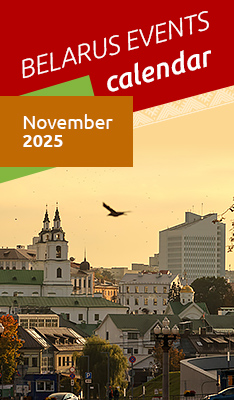




 print version
print version make home page
make home page add to bookmarks
add to bookmarks